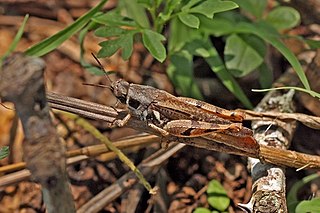
The subfamily Catantopinae is a group of insects classified under family Acrididae. Genera such as Macrotona may sometimes called "spur-throated grasshoppers", but that name is also used for grasshoppers from other subfamilies, including the genus Melanoplus from the Melanoplinae.
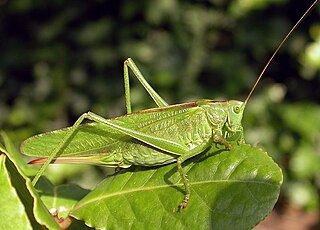
The Tettigoniinae are a subfamily of bush crickets or katydids, which contains hundreds of species in about twelve tribes.

Gryllacrididae are a family of non-jumping insects in the suborder Ensifera occurring worldwide, known commonly as leaf-rolling crickets or raspy crickets. The family historically has been broadly defined to include what are presently several other families, such as Stenopelmatidae and Rhaphidophoridae, now considered separate. As presently defined, the family contains two subfamilies: Gryllacridinae and Hyperbaeninae. They are commonly wingless and nocturnal. In the daytime, most species rest in shelters made from folded leaves sewn with silk. Some species use silk to burrow in sand, earth or wood. Raspy crickets evolved the ability to produce silk independently from other insects, but their silk has many convergent features to silkworm silk, being made of long, repetitive proteins with an extended beta-sheet structure.
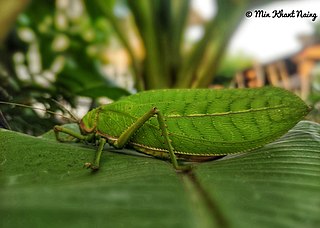
The subfamily Pseudophyllinae contains numerous species in the family Tettigoniidae, the katydids or bush crickets. Sometimes called "true katydids", together with the crickets of suborder Ensifera, they form part of the insect order Orthoptera which also contains grasshoppers.

The Phaneropterinae, the sickle-bearing bush crickets or leaf katydids, are a subfamily of insects within the family Tettigoniidae. Nearly 2,060 species in 85 genera throughout the world are known. They are also known as false katydids or round-headed katydids.
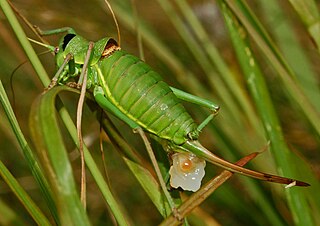
The Bradyporinae are a subfamily in the family Tettigoniidae, based on the type genus Bradyporus. First described as a family, "Bradyporidae" (Burmeister, H., 1838), the first use as Bradyporinae was by Brunner von Wattenwyl in 1878.

Oxyinae is subfamily of grasshoppers in the family Acrididae. Species are distributed throughout Africa and Australasia.
Himertula is a genus of bush crickets in the subfamily Phaneropterinae and tribe Letanini. Species can be found mostly in the Indian sub-continent.
Hemigyrus is an Asian genus of bush-crickets in the tribe Phyllomimini and the subfamily Pseudophyllinae. Species have been recorded from: southern China and Indo-China.
Paramorsimus is a genus of Asian bush-crickets in the tribe Phyllomimini and the subfamily Pseudophyllinae. Species have been recorded from India, Indochina (Vietnam) and Malesia.

Ducetia is the type genus of the Ducetiini: a tribe of bush crickets. The genus was erected by Carl Stål and species have a widespread distribution in Africa, Asia and Australia.
Isopsera is an Asian genus of bush crickets in the subfamily Phaneropterinae. Species can be found in India, Indochina, Malesia and the Pacific Islands.
Orthelimaea is a genus of Asian bush crickets in the subfamily Phaneropterinae. Species in this genus are found in India, Indo-China, and Malesia.
Ectadia is a genus of Asian bush crickets of the tribe Elimaeini. Records are primarily from southern China and Indochina.
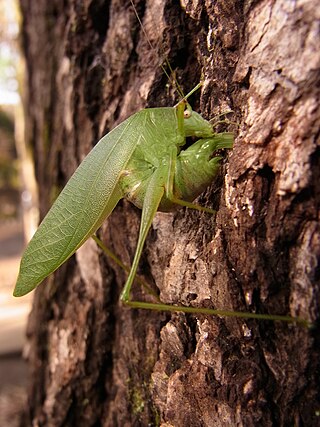
Holochlora japonica, the Japanese broadwinged katydid, is a species of katydid or bush cricket native to eastern Asia in the large subfamily Phaneropterinae.

Poecilimon is a genus of bush crickets in the subfamily Phaneropterinae and tribe Barbitistini. Species can be found in: central and Southeast Europe, the south of the European part of the former USSR, Asia Minor, Syria, Palestine, the Caucasus, Persia and extends in Central Asia to the Altai Mountains.

The Ephippigerini are a tribe of bush crickets in the subfamily Bradyporinae, erected by Brunner von Wattenwyl in 1878. Species have been recorded from mainland Europe, North Africa and the Horn of Africa.

The Ommatolampidinae are a subfamily of grasshoppers in the family Acrididae, found in central and South America, and based on the type genus Ommatolampis. Derived from the "Ommatolampides" used by Brunner von Wattenwyl in 1893, the first use of the name in its current form was by Rodríguez et al. in 2013; this taxon appears to be paraphyletic.

Ancistrura is a monotypic genus of European bush crickets in the subfamily Phaneropterinae and tribe Barbitistini, erected by Boris Uvarov in 1921.














